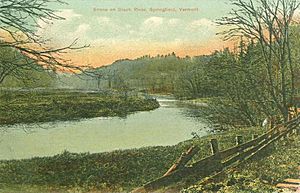Black River (Connecticut River tributary) facts for kids
The Black River is a river in the state of Vermont, U.S.. It flows for about 40.8 miles (65.7 km). This river is a tributary, which means it flows into a larger river. The Black River joins the Connecticut River.
The area of land that drains into the Black River is called its watershed or drainage basin. This area covers about 202 square miles (523 km²) in southeastern Vermont. Most of this land is in Windsor County.
Contents
Journey of the Black River
The Black River starts in a small pond called Black Pond. This pond is located in Plymouth, Vermont. As the river flows, it is narrow at first. It gathers water from many small brooks and streams. Overhanging tree branches help keep the water cool.
Lakes and Towns Along the Way
The Black River passes through several lakes. These include Amherst Lake, Echo Lake, Lake Rescue, and Lake Pauline. After these lakes, the river flows through the town of Ludlow. Ludlow is known for Okemo Mountain Ski Resort.
The river then tumbles through an impressive area called Cavendish Gorge. It widens as it goes under the Downers Covered Bridge. Then, it enters the town of Perkinsville.
Joining Forces: North Branch and Flood Control
A part of the river called the North Branch of the Black River also exists. Its source is in Reading. This branch joins the main Black River in Weathersfield. They meet near a special dam built to control floods.
The Army Corps of Engineers built this dam between 1957 and 1960. Its purpose is to hold back water. This helps protect towns downstream, like North Springfield and Springfield, from big floods.
Final Stretch to the Connecticut River
After the dam, the Black River continues through North Springfield and Springfield. It flows past small dams and many old industrial areas. Finally, it meets the Connecticut River at a place called Hoyt's Landing. This spot is across from New Hampshire's Fort at Number 4 in Charlestown.
The Black River's watershed is located between two other rivers. It is south of the Ottauquechee River and north of the Williams River.
History of the Black River
The Black River has been very important to the town of Springfield. People settled in Springfield in the mid-1700s. The river was a key source of power for many factories built along its banks. Many small dams were built near the impressive Comtu Falls. These falls are in the center of Springfield and are officially called Black River Falls.
Past Floods
Flooding was a common problem on the Black River. A very big flood happened in 1927. A strong storm brought heavy rains to the lower parts of the river's watershed in early November. The small streams that feed the river overflowed. They sent huge amounts of water into the Black River. This caused homes to be lost and businesses to be damaged.




